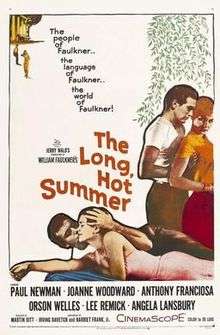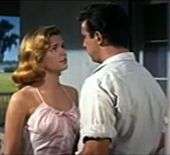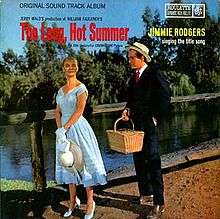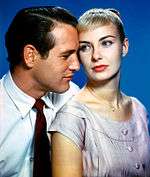The Long, Hot Summer
The Long, Hot Summer is a 1958 American drama film directed by Martin Ritt. The screenplay was written by Irving Ravetch and Harriet Frank Jr., based in part on three works by William Faulkner: the 1931 novella "Spotted Horses", the 1939 short story "Barn Burning" and the 1940 novel The Hamlet. The title is taken from The Hamlet, as Book Three is called "The Long Summer". Some characters, as well as tone, were inspired by Tennessee Williams' 1955 play, Cat on a Hot Tin Roof, a film adaptation of which – also starring Paul Newman – was released five months later.[2]
| The Long, Hot Summer | |
|---|---|
 Theatrical release poster | |
| Directed by | Martin Ritt |
| Produced by | Jerry Wald |
| Written by | William Faulkner Irving Ravetch Harriet Frank Jr. |
| Starring | Paul Newman Joanne Woodward Orson Welles |
| Music by | Alex North |
| Cinematography | Joseph LaShelle |
| Edited by | Louis R. Loeffler |
| Distributed by | 20th Century Fox |
Release date |
|
Running time | 115 minutes |
| Country | United States |
| Language | English |
| Budget | $1.5 million |
| Box office | $3.5 million (US/Canada rentals)[1] |
The plot follows the conflicts of the Varner family after ambitious drifter Ben Quick (Newman) arrives in their small Mississippi town. Will Varner (Orson Welles), the patriarch, has doubts about his son, Jody (Anthony Franciosa) and sees Ben as a better choice to inherit his position. Will tries to push Ben and his daughter Clara (Joanne Woodward) into marriage.
Filmed in Clinton, Louisiana, the cast was composed mostly of former Actors Studio students, whom Ritt met while he was an assistant teacher to Elia Kazan. For the leading role, Warner Bros. loaned Newman to 20th Century Fox. The production was marked by conflicts between Welles and Ritt, which drew media attention. The music score was composed by Alex North and the title song, "The Long Hot Summer", written by North and Sammy Cahn, was performed by Jimmie Rodgers.
The film was well received by critics but did not score significant results at the box office. Its critical success revitalized Ritt's career, after his having been blacklisted during most of the 1950s. Newman won the Best Actor Award at the Cannes Film Festival.
Plot

Ben Quick is on trial for barn-burning, but when no solid evidence is found, the judge expels him from town. Ben hitches a ride to Frenchman's Bend, Mississippi, with two young women in a convertible, Clara Varner and her sister-in-law Eula (Lee Remick). Clara's father, Will Varner, is the domineering owner of most of the town.
Ben goes to the Varner plantation. Will is away, but his only son, Jody, agrees to let Ben become a sharecropper on a vacant farm. When Will returns from a stay in the hospital, he is furious at Jody for hiring a notorious "barn burner", but soon begins to see in Ben a younger version of himself and comes to admire his ruthlessness and ambition, qualities that Jody lacks. Will is also disappointed with the man that his 23-year-old daughter, Clara, has been seeing for five or six years: Alan Stewart (Richard Anderson), a genteel Southern "blue blood" and a mama's boy.
Will therefore schemes to push his daughter and Ben together, to try to bring fresh, virile blood into the family. However, she is openly hostile to the crude, if magnetic, upstart. Will is determined to have his bloodline go on, so he offers to make Ben wealthy if he marries Clara. Meanwhile, Minnie Littlejohn (Angela Lansbury), Will's long-time mistress, is dissatisfied with their arrangement and wants to marry him.

Jody becomes increasingly frustrated, seeing his position in the family being undermined. After Ben sells some wild horses for Will, he is rewarded with the position of clerk in the general store, alongside Jody. Will even invites him to live in the family mansion.
This is the final straw for Jody. He pulls a gun on Ben and threatens to kill him. Ben talks his way out by telling Jody about buried Civil War-era treasure he has supposedly found on a property that Will gave him, a down payment to seal their bargain over Clara. Jody starts digging and finds a bag of coins. He is elated, thinking he might finally free himself of his father's domination; he buys the land from Ben. Late that night, Will finds his son, still digging. After examining one of the coins, Will notices that it was minted in 1910. Jody is shattered.
Ben aggressively pursues Clara. She finally asks Alan what his intentions are, and does not like what she hears. A defeated Jody finds his father alone in their barn. Jody bolts the entrance and sets the barn on fire, but he cannot go through with it and releases Will. The incident leads to a reconciliation between father and son. Men from town assume Ben is the culprit and start toward him, but Clara persuades him to get into her car and they drive away. Then Will claims he accidentally started the fire by dropping his cigar.
The smell of fire brings back bad memories for Ben, who confesses to Clara that his father was a real barn-burner. He tells her how, at age ten, he warned a farmer that his father was about to set another fire. Ben's father got away, never to be seen again. Ben tells her he is leaving town, but Clara makes it clear she has fallen in love with him. An elated Will confides to Minnie that life is so good, he may have to live forever.
Cast
- Paul Newman as Ben Quick. Newman met director Martin Ritt as a student at the Actors Studio, where Ritt was a teacher-assistant for Elia Kazan.[3] Newman, who was under a contract with Warner Brothers, was loaned to 20th Century Fox for a fee of US$75,000. Meanwhile, his contract earned him US$17,500 for each ten-week shot.[4] He traveled to Clinton, Louisiana, before the start of filming to study the mannerisms, accent and speech of the Southern men in order to create a proper characterization.[5]
- Orson Welles as Will Varner. The character was inspired by Big Daddy Pollitt from Tennessee Williams' play Cat on a Hot Tin Roof.[2] Welles' presence on the film was marked by multiple conflicts with director Martin Ritt. He agreed to take the role due to a tax debt of US$150,000; he stated years later, "I hated making Long Hot Summer. I've seldom been as unhappy in a picture".[6]
Director Martin Ritt met the three cast members listed below while they were students at the Actors Studio.[7][8]
- Joanne Woodward as Clara Varner. Woodward ended up marrying co-star Newman in 1958.
- Anthony Franciosa as Jody Varner
- Lee Remick as Eula Varner. Remick later admitted that during the shooting she was intimidated by Orson Welles on the set because of his "icon" status.[9]
The supporting roles were played by:
- Angela Lansbury as Minnie Littlejohn
- Richard Anderson as Alan Stewart
- Sarah Marshall as Agnes Stewart
- Mabel Albertson as Elizabeth Stewart
- J. Pat O'Malley as Ratliff
- William "Bill" Walker as Lucius
- Francis Sibley as the bass player in the band.[10]
Production
Development
Producer Jerry Wald hired former co-worker and Warner Brothers director Martin Ritt to shoot the adaptation of two William Faulkner novels based on a recommendation by script writer Irving Ravetch.[11] Wald convinced the studio executives to pay US$50,000 for the rights for the novels The Sound and the Fury and The Hamlet. The first to be produced, The Hamlet, was renamed The Long Hot Summer to avoid confusion with William Shakespeare's play Hamlet.[12] Ravetch and Harriet Frank, Jr. wrote the script, also adding fragments from Faulkner's short stories "Barn Burning" and "Spotted Horses".[13] In the new script, the book's main character, Flem Snopes, and the rest of the Snopes family were removed. The plot was recentered on a minor character, Ben Quick, and the reconciliation of the Varner family.[14][15] On their first important screenplay, Ravetch and Frank implemented their signature style, using the names of characters and a few details of the plot but significantly modifying the details of the story.[16] The final product was heavily influenced by Tennessee Williams' play Cat on a Hot Tin Roof,[17] resulting in an "erotically charged" story.[18][19]
Locations
The film was shot in Clinton and Baton Rouge, Louisiana, in CinemaScope color,[12] with a budget of US$1,645,000.[20] A Southern Gothic story,[19] Ritt decided to shoot it on location to capture the characteristics of the area, emphasizing the regional details.[13] Ritt met leading actor Paul Newman while teaching at the Actors Studio. The rest of the main cast also consisted of former Actors Studio alumni, including Joanne Woodward, Anthony Franciosa and Lee Remick.[12]
Casting
The film attracted attention for the appearance of Orson Welles as Will Varner, the patriarch of the family. 20th Century Fox wanted to avoid casting Welles because of his temperament, but the studio was persuaded by Ritt, who considered him the right actor for the role.[12][21] The director and the actor had several marked differences during the shooting of the movie, which included problems with the interpretation of the lines, costume design and the position of Welles while shooting the scenes.[22] At one point during the production, Welles informed Ritt that he did not want to memorize his lines, requesting instead that they be dubbed afterwards.[23] Part of the cast was intimidated by Welles' temperamental attitude.[24]
The conflicts between Welles and Ritt attracted media attention. Immediately after filming was completed, during an interview with Life, Welles explained that the cause of his behavior was that he did not know what kind of "monkeyshines" his co-stars would be or the "caprices" they would receive from him. He also stated that they overcame the differences and completed the film.[25] Welles later wrote a letter to Ritt praising his work and apologizing for his interference during the making of the movie. Ritt replied, expounding his admiration for Welles.[26] Despite the mutual apologies, during an interview in 1965, Ritt recalled an incident on the set. While the film was being shot, it was often stopped by bad weather. During a day suitable for shooting, he found Welles not ready for the scene, instead reading a newspaper in Spanish. Ritt decided to skip Welles's scene and shoot the next one. He attributed Welles's later cooperation to the incident, which Welles had found humiliating. Ritt thus earned the nickname "the Orson Tamer" throughout the Hollywood community.[24]
Soundtrack
| The Long Hot Summer | |
|---|---|
 | |
| Soundtrack album by | |
| Released | June 1958 |
| Length | 35:58 |
| Label | Roulette Records |
| "The Long, Hot Summer" song | |
Audio sample featuring vocal by Jimmie Rodgers
| |
Alex North composed the film's score, which leaned toward a jazz style. "The Long Hot Summer" was the only song written by North to be used as the title track of a film. Composed in an AABA form, it was characterized by its lyricisms and its "tense dissonant" jazz-figures. The lyrics of the song were written by Sammy Cahn, while instrumental variations of the melody were used throughout the film, underlining the progression of the relationship between Ben and Clara.[27] Recorded by Jimmie Rodgers, it was released by Roulette Records, reaching number 77 on Billboard's Top 100 Sides in June 1958.[28] The orchestra was conducted by Lionel Newman.[29][30]
Billboard described the soundtrack as "a model of music use in a dramatic film".[31] On another review, Billboard favored the album, stating that it "makes for good listening out of the cinematic context" and that the financial success of the soundtrack may have been propelled by Jimmie Rodgers' "smooth vocal treatment". The publication praised North's musical understanding of the deep South, and particularly praised the song "Eula", describing it as a "pure gem of sex-on-wax".[32]
| No. | Title | Length |
|---|---|---|
| 1. | "The Long, Hot Summer" | 2:26 |
| 2. | "Ashamed – Gentlemen" | 6:04 |
| 3. | "Two Butterflies" | 2:30 |
| 4. | "The Lynchers – The Barn Burns – Joy" | 4:50 |
| 5. | "Big Daddy – Crushed" | 1:55 |
| 6. | "Eula" | 3:20 |
| 7. | "Barn Burners" | 4:50 |
| 8. | "Loot – Respect" | 4:40 |
| 9. | "Encounter" | 2:05 |
| 10. | "The Long, Hot Summer – Summertime" | 3:18 |
Release and reception

The movie opened to good reviews but did not score a significant profit at the box office,[33] grossing US$3,500,000.[34] Billboard commended the acting as "first-rate" and "robust", with particular praise for Woodward, and also praised Ritt's direction.[31] Meanwhile, The Reporter highlighted the film's similarities to the play Cat on a Hot Tin Roof and described the cast as "an impressive one", but remarked that the actors and characters "never seem to get together". The review called Welles "great" and "gusty", but described Woodward's participation as a "poker bluff".[35]
Time described Newman's performance as "mean and keen as a cackle-edge scythe". The publication also praised Woodward, stating her acting was delivered with "fire and grace not often seen in a movie queen", but decried Welles's acting as "scarcely an improvement" on his performance in his previous role, in Moby Dick.[36] Variety praised the scriptwriters for the successful merging of the three Faulkner stories that inspired the film. The review also praised Martin Ritt, the camerawork by Joseph LaShelle, and the film's musical score.[37] Cosmopolitan called the movie a "gutsy melodrama".[38]
Legacy
The film reestablished the career of Martin Ritt, who had been on the blacklist for most of the decade for alleged associations with communists.[39] Paul Newman's performance as Ben Quick brought him national fame,[40] as well as the Best Actor Award at the Cannes Film Festival. During the production, Newman married co-star Joanne Woodward.[41] In 2002, the film was nominated for the American Film Institute's AFI's 100 Years...100 Passions list.[42]
A television series of the same name aired between 1965 and 1966, featuring Dan O'Herlihy, Roy Thinnes, Nancy Malone, Lana Wood, Ruth Roman, and Edmond O'Brien.[43] It was remade for television in 1985, featuring Jason Robards, Don Johnson, and Cybill Shepherd. This rendition received two Emmy nominations, for Outstanding Miniseries and Outstanding Art Direction for a Miniseries or a Special.[44]
Footnotes
- Cohn, Lawrence (October 15, 1990). "All-Time Film Rental Champs". Variety. p. M170.
- Miller, Gabriel 2000, p. 29.
- United States Congress 2009, p. 23427.
- Lax, Eric 1996, p. 83.
- Quirk, Lawrence 2009, p. 75.
- Quirk, Lawrence 2009, p. 76.
- Miller, Gabriel 2003, p. 165, 166.
- Benard, Jami 2005, p. 187.
- Jackson, Carlton 1994, p. 51.
- "Obituary for Francis Martin Sibley | Shaw – Davis Funeral Home". Obituary for Francis Martin Sibley. Shaw-Davis Funerals. Retrieved 10 December 2019.
- Buhle & Wagner 2003, p. 185.
- Miller, Gabriel 2000, p. 27.
- Miller, Gabriel 2003, p. 191.
- Palmer & Bray 2009, p. 217.
- Miller, Gabriel 2000, p. 28.
- Miller, Gabriel 2000, p. 29, 30, 31, 32.
- Quirk, Lawrence 2009, p. 75.
- Miller, Gabriel 2003, p. 191.
- Benard, Jami 2005, p. 188.
- Solomon, Aubrey 1989, p. 251.
- Miller, Gabriel 2000, p. 28.
- Jackson, Carlton 1994, p. 50.
- Quirk, Lawrence 2009, p. 76.
- Jackson, Carlton 1994, p. 51.
- Life magazine staff 1958, p. 53.
- Jackson, Carlton 1994, p. 52.
- Lenderson & Williams 2009, p. 56.
- Billboard Staff 1958, p. 34.
- iTunes staff 2008.
- Soundtrack Collector staff 2006.
- Sinclair, Charles 1958, p. 7.
- Billboard Staff (2) 1958, p. 3.
- Jackson, Carlton 1994, p. 53, 54.
- Matelski, Marilyn 1991, p. 116.
- Weales, Gerard 1958, p. 43, 44.
- Times staff 1958, p. 86.
- Variety staff 1957.
- Cosmo 1958, p. 12, 13.
- Gilliam, Richard 2013.
- Cornelison & Yanak 2004, p. 351.
- Schwartz, Richard 2009, p. 368.
- "AFI's 100 Years...100 Passions Nominees" (PDF). Retrieved 2016-08-21.
- Lisante, Tom 2000, p. 186, 187.
- Latham, Caroline 1985, p. 123.
See also
References
- Billboard Staff (June 8, 1958). "Top 100 Sides". Billboard. 70 (26). ISSN 0006-2510.CS1 maint: ref=harv (link)
- Billboard Staff (2) (June 2, 1958). "Album Reviews". Billboard. ISSN 0006-2510.CS1 maint: ref=harv (link)
- Benard, Jami (2005). The X List: The National Society of Film Critics' Guide to the Movies That Turn Us On. Da Capo Press. ISBN 978-0-306-81445-7.CS1 maint: ref=harv (link)
- Buhle, Paul; Wagner, Dave (2003). Hide in Plain Sight: The Hollywood Blacklistees in Film and Television, 1950–2002. Palgrave Macmillan. ISBN 978-1-4039-6144-0.CS1 maint: ref=harv (link)
- Cornelison, Pam; Yanak, Ted (2004). The Great American History Fact-Finder: The Who, What, Where, When, and Why of American History. Houghton Mifflin Harcourt. ISBN 978-0-618-43941-6.CS1 maint: ref=harv (link)
- "Movie Reviews". Cosmopolitan. Schlicht & Field. 1958.
- iTunes staff (2008). "The Long, Hot Summer (Original Film Soundtrack)". iTunes. Apple Corporation. Retrieved February 27, 2013.CS1 maint: ref=harv (link)
- Gilliam, Richard (2013). "The Long, Hot Summer review". All Movie. Retrieved March 1, 2013.CS1 maint: ref=harv (link)
- Jackson, Carlton (1994). Picking Up the Tab: The Life and Movies of Martin Ritt. Popular Press. ISBN 978-0-87972-672-0.CS1 maint: ref=harv (link)
- Lax, Eric (1996). Paul Newman: A Biography. Turner Publishing. ISBN 978-1-57036-286-6.CS1 maint: ref=harv (link)
- Lenderson, Sanya; Williams, John (2009). Alex North, Film Composer. McFarland. ISBN 978-0-7864-4333-8.CS1 maint: ref=harv (link)
- Life magazine staff (February 24, 1958). "The Return of Awesome Welles". Life Magazine. 44 (8). ISSN 0024-3019.CS1 maint: ref=harv (link)
- Latham, Caroline (1985). Miami Magic. Kensington Publishing Corporation. ISBN 978-0-8217-1800-1.CS1 maint: ref=harv (link)
- Lisante, Tom (2000). Fantasy Femmes of 60s Cinema: Interviews With 20 Actresses from Biker, Beach, and Elvis Movies. McFarland. ISBN 978-0-7864-0868-9.CS1 maint: ref=harv (link)
- Matelski, Marilyn (1991). Variety: Film, Video, Theatre, Music. Focal Press. ISSN 0959-1486.CS1 maint: ref=harv (link)
- Miller, Gabriel (2000). The Films of Martin Ritt: Fanfare for the Common Man. University Press of Mississippi. ISBN 978-1-61703-496-1.CS1 maint: ref=harv (link)
- Miller, Gabriel (2003). Martin Ritt: Interviews. Univ. Press of Mississippi. ISBN 978-1-57806-433-5.CS1 maint: ref=harv (link)
- Palmer, William; Bray, William Robert (2009). Hollywood's Tennessee: The Williams Films and Postwar America. University of Texas Press. ISBN 978-0-292-71921-7.CS1 maint: ref=harv (link)
- Quirk, Lawrence (2009). Paul Newman: A Life. Taylor Trade Publications. ISBN 978-1-58979-438-2.CS1 maint: ref=harv (link)
- Schwartz, Richard (2009). The 1950s. Infobase Publishing. ISBN 978-1-4381-0876-6.CS1 maint: ref=harv (link)
- Sinclair, Charles (April 14, 1958). "Reviewed in Brief". Billboard. 70 (18). ISSN 0006-2510.CS1 maint: ref=harv (link)
- Solomon, Aubrey (1989). Twentieth Century Fox: A Corporate and Financial History (The Scarecrow Filmmakers Series). Scarecrow Press. ISBN 978-0-8108-4244-1.CS1 maint: ref=harv (link)
- Soundtrack Collector staff (2006). "Long, Hot Summer, The (1958)". Soundtrack Collector. C&C Concept and Creation. Retrieved February 27, 2013.CS1 maint: ref=harv (link)
- Times staff (1958). "Time Magazine Journal". Time Magazine. 71.CS1 maint: ref=harv (link)
- United States Congress (2009). Congressional Record: Proceedings and Debates of the 110th Congress. Government Printing Office.CS1 maint: ref=harv (link)
- Variety staff (December 31, 1957). "The Long, Hot Summer". Variety. Retrieved March 1, 2013.CS1 maint: ref=harv (link)
- Pryor, Thomas (27 July 1958). "Hollywood Scene: Jerry Wald Presents His Treasurer's Report – Blaustein's 'Horsemen'". New York Times. p. X5.
- Weales, Gerard (1958). "Movie Reviews". The Reporter. 18.CS1 maint: ref=harv (link)
External links
| Wikimedia Commons has media related to The Long, Hot Summer. |